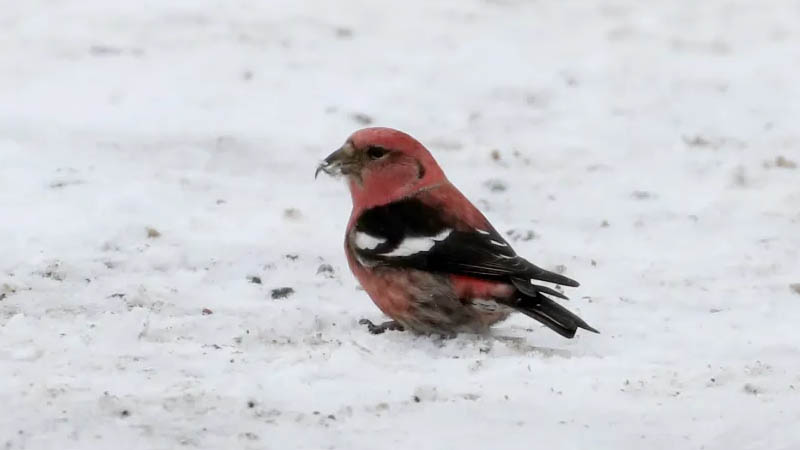White-winged Crossbill
Loxia leucoptera leucoptera (Gmelin 1789)
Photo: @ Jay McGowan

Appearance
Medium-sized finch red (males) to yellow (females) finch with distinctive mandibles curved and crossed at the tip.
Size: L 6.5″
Shape: Fairly small, short-tailed (although longest-tailed of the crossbills relative to body size) short-legged, big-headed, broad-necked bird with a distinctive fairly thin bill with tips that cross each other. Tail deeply notched; primary projection very long (2.5 x bill length).
Both Sexes: Two broad, well-defined white wingbars; white-tipped tertials (lacking on Red Crossbill).
Adult Male: Head, rump, and most underparts pinkish-red; back all black to mostly red; rear flanks paler and strongly to indistinctly streaked darker.
Adult Female: Variably faintly greenish (sometimes yellowish) on crown, back, rump, and breast; otherwise, grayish-brown upperparts and darkly streaked
with brown.
1st Year: M. mixed brown with pinkish-red or orangish yellow; f. brownish or faintly greenish.
Juv: (Jan.–Oct.) (can breed in winter) Brownish overall with heavy brown streaking on whitish underparts; occasionally greenish or yellowish feathers, whitish wingbars. May breed in this plumage.
Natural History
Medium-sized finch rosy-red (males) to yellow (females) finch with distinctive mandibles curved and crossed at the tip.
Is the dominant crossbill across the boreal forest of Canada with occasional nesting in the northeastern states, Cascades to central Oregon, central Rockies to northern New Mexico, and along coastal areas of western Canada; in irruption years will move south into Plains and Appalachians. Feeds primarily on Tamarack and White and Black Spruce across the closed boreal forest of Canada; additionally uses Red Spruce in the northeastern states and southern Maritimes, Engelmann Spruce in Rockies, and rarely Sitka Spruce along coastal Alaska or Douglas Fir in British Columbia. Will use a variety of conifers during irruptions south of normal breeding range too. The main flight call given by the White-winged Crossbill is a chattering very redpoll-like chyet–chyet or chet–chet call, usually doubled or tripled, and repeated once every second or two.
Taxonomy
Two subspecies, White-winged Crossbill (L. l. leucoptera) in North America and Two-barred Crossbill, (L. l. bifasciata) across Eurasia. White-winged Crossbill is larger, has less black on back and wing coverts, has a larger, deeper bill. Based on bill structure which is tied to foraging rates, and differences in calls and ecology, the two subspecies might warrant full species status with more research.
Two-barred CrossbillLoxia leucoptera bifasciata
-> N Europe to E Siberia and NW China
White-winged CrossbillLoxia leucoptera leucoptera
-> Alaska, Canada and N USA
Object of study
Taxonomic status between the two subspecies.
Flight Call —
For more on White-winged Crossbill see here:
ARTICLE
Irruptions
Highly irregular outside the boreal spruce forest of Canada, but occasionally breeds in small to modest numbers in montane western Engelmann Spruce forests, and rarely irrupts south of eastern border states into the Plains and southern Northeastern States. Some years hifher numbers than usual can found in western montane areas, winter 2020-21 looks like it’s one of those years.
Irruptions: Found in the mountains across parts of the montane western states in numbers better than usual. In the east, small numbers likely linger in the Great Lakes with small numbers possibly moving into the northeastern states.



